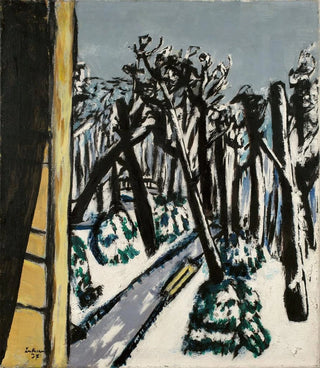Art print | Winter Zoo - Max Beckmann


View from behind

Frame (optional)
In the vibrant world of modern art, "Zoo en hiver" by Max Beckmann stands out for its emotional depth and narrative richness. This iconic artwork, painted in 1946, evokes not only the human condition but also the tumult of an era marked by war and disillusionment. Beckmann, with his unique style, takes us on a visual journey where animals become metaphors for human anxieties and aspirations. Through this art print, viewers are invited to contemplate a world where nature and man intertwine, creating an atmosphere that is both fascinating and unsettling.
Style and uniqueness of the work
Max Beckmann's style is often characterized by angular shapes and vibrant colors, and "Zoo en hiver" is no exception. The human and animal figures, rendered with dramatic intensity, seem to emerge from a troubled dream. The contrasts of light and shadow give the piece a dynamic quality, enhancing the feeling of anxiety and isolation. The composition is carefully orchestrated, with each element loaded with symbolism. The animals, far from being mere representations, embody complex emotions, while the human characters, often frozen in melancholic poses, evoke a desperate quest for meaning. Thus, Beckmann manages to capture the essence of a troubled period while offering a timeless reflection on the human condition.
The artist and his influence
Max Beckmann, a major figure of German expressionism, transcended the artistic conventions of his time. Born in 1884 in Leipzig, he experienced the political and social upheavals of the 20th century, which profoundly influenced his work. His ability to translate the darkest human emotions into powerful images grants him a prominent place in art history. Beckmann was also a pioneer in using color and form to express complex feelings, inspiring many contemporary and future artists. "Zoo en hiver" is a perfect example of his innovative approach, blending mastered technique with a personal vision of the world. His legacy endures, inviting future generations to explore depths

Matte finish

View from behind

Frame (optional)
In the vibrant world of modern art, "Zoo en hiver" by Max Beckmann stands out for its emotional depth and narrative richness. This iconic artwork, painted in 1946, evokes not only the human condition but also the tumult of an era marked by war and disillusionment. Beckmann, with his unique style, takes us on a visual journey where animals become metaphors for human anxieties and aspirations. Through this art print, viewers are invited to contemplate a world where nature and man intertwine, creating an atmosphere that is both fascinating and unsettling.
Style and uniqueness of the work
Max Beckmann's style is often characterized by angular shapes and vibrant colors, and "Zoo en hiver" is no exception. The human and animal figures, rendered with dramatic intensity, seem to emerge from a troubled dream. The contrasts of light and shadow give the piece a dynamic quality, enhancing the feeling of anxiety and isolation. The composition is carefully orchestrated, with each element loaded with symbolism. The animals, far from being mere representations, embody complex emotions, while the human characters, often frozen in melancholic poses, evoke a desperate quest for meaning. Thus, Beckmann manages to capture the essence of a troubled period while offering a timeless reflection on the human condition.
The artist and his influence
Max Beckmann, a major figure of German expressionism, transcended the artistic conventions of his time. Born in 1884 in Leipzig, he experienced the political and social upheavals of the 20th century, which profoundly influenced his work. His ability to translate the darkest human emotions into powerful images grants him a prominent place in art history. Beckmann was also a pioneer in using color and form to express complex feelings, inspiring many contemporary and future artists. "Zoo en hiver" is a perfect example of his innovative approach, blending mastered technique with a personal vision of the world. His legacy endures, inviting future generations to explore depths






